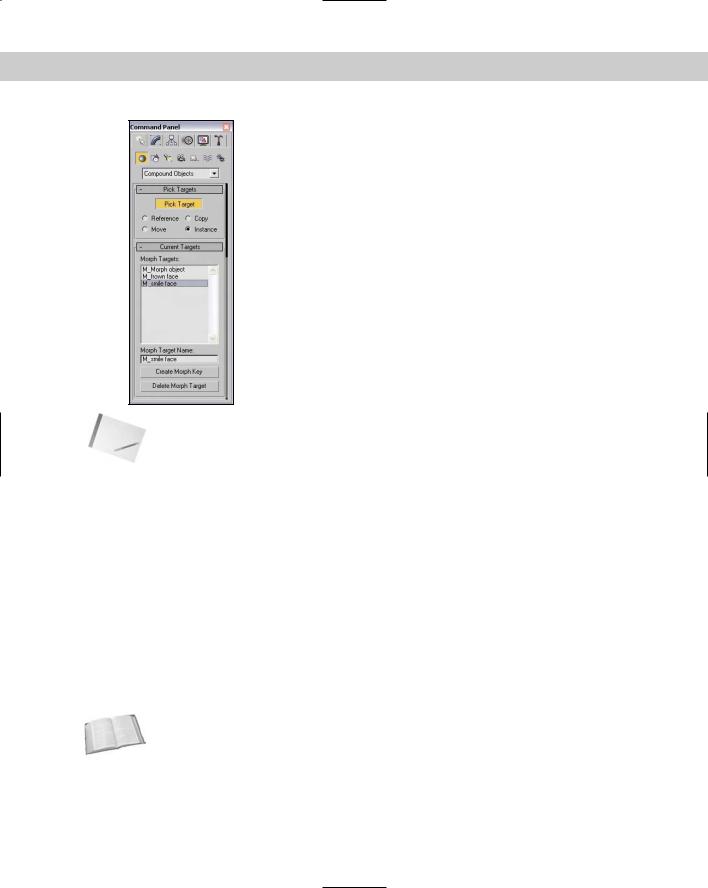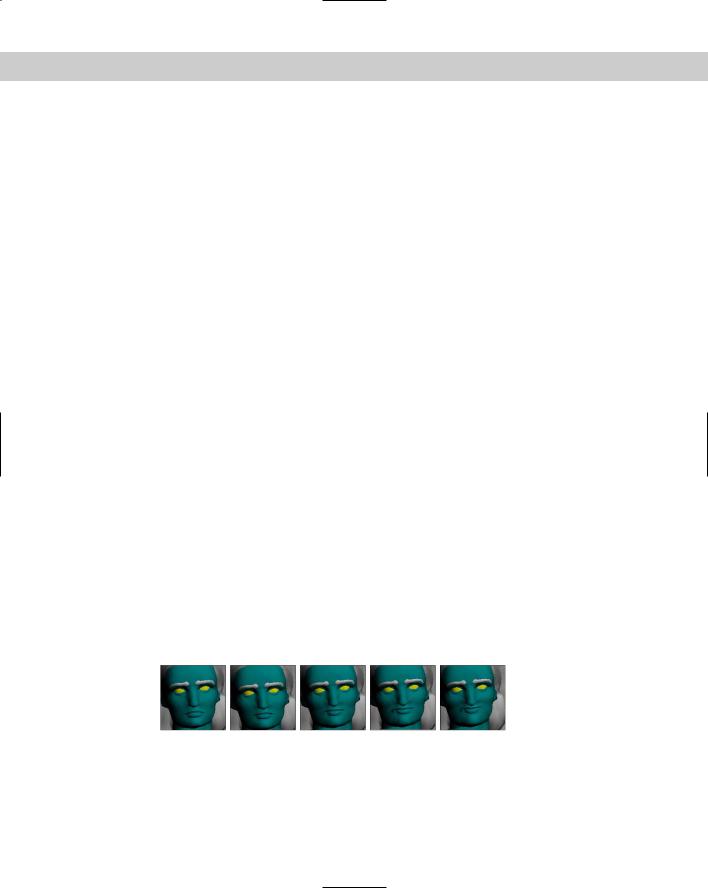
- •Preface
- •About This Book
- •Acknowledgments
- •Contents at a Glance
- •Contents
- •Relaxing at the Beach
- •Dressing the Scene
- •Animating Motion
- •Rendering the Final Animation
- •Summary
- •The Interface Elements
- •Using the Menus
- •Using the Toolbars
- •Using the Viewports
- •Using the Command Panel
- •Using the Lower Interface Bar Controls
- •Interacting with the Interface
- •Getting Help
- •Summary
- •Understanding 3D Space
- •Using the Viewport Navigation Controls
- •Configuring the Viewports
- •Working with Viewport Backgrounds
- •Summary
- •Working with Max Scene Files
- •Setting File Preferences
- •Importing and Exporting
- •Referencing External Objects
- •Using the File Utilities
- •Accessing File Information
- •Summary
- •Customizing Modify and Utility Panel Buttons
- •Working with Custom Interfaces
- •Configuring Paths
- •Selecting System Units
- •Setting Preferences
- •Summary
- •Creating Primitive Objects
- •Exploring the Primitive Object Types
- •Summary
- •Selecting Objects
- •Setting Object Properties
- •Hiding and Freezing Objects
- •Using Layers
- •Summary
- •Cloning Objects
- •Understanding Cloning Options
- •Mirroring Objects
- •Cloning over Time
- •Spacing Cloned Objects
- •Creating Arrays of Objects
- •Summary
- •Working with Groups
- •Building Assemblies
- •Building Links between Objects
- •Displaying Links and Hierarchies
- •Working with Linked Objects
- •Summary
- •Using the Schematic View Window
- •Working with Hierarchies
- •Setting Schematic View Preferences
- •Using List Views
- •Summary
- •Working with the Transformation Tools
- •Using Pivot Points
- •Using the Align Commands
- •Using Grids
- •Using Snap Options
- •Summary
- •Exploring the Modifier Stack
- •Exploring Modifier Types
- •Summary
- •Exploring the Modeling Types
- •Working with Subobjects
- •Modeling Helpers
- •Summary
- •Drawing in 2D
- •Editing Splines
- •Using Spline Modifiers
- •Summary
- •Creating Editable Mesh and Poly Objects
- •Editing Mesh Objects
- •Editing Poly Objects
- •Using Mesh Editing Modifiers
- •Summary
- •Introducing Patch Grids
- •Editing Patches
- •Using Modifiers on Patch Objects
- •Summary
- •Creating NURBS Curves and Surfaces
- •Editing NURBS
- •Working with NURBS
- •Summary
- •Morphing Objects
- •Creating Conform Objects
- •Creating a ShapeMerge Object
- •Creating a Terrain Object
- •Using the Mesher Object
- •Working with BlobMesh Objects
- •Creating a Scatter Object
- •Creating Connect Objects
- •Modeling with Boolean Objects
- •Creating a Loft Object
- •Summary
- •Understanding the Various Particle Systems
- •Creating a Particle System
- •Using the Spray and Snow Particle Systems
- •Using the Super Spray Particle System
- •Using the Blizzard Particle System
- •Using the PArray Particle System
- •Using the PCloud Particle System
- •Using Particle System Maps
- •Controlling Particles with Particle Flow
- •Summary
- •Understanding Material Properties
- •Working with the Material Editor
- •Using the Material/Map Browser
- •Using the Material/Map Navigator
- •Summary
- •Using the Standard Material
- •Using Shading Types
- •Accessing Other Parameters
- •Using External Tools
- •Summary
- •Using Compound Materials
- •Using Raytrace Materials
- •Using the Matte/Shadow Material
- •Using the DirectX 9 Shader
- •Applying Multiple Materials
- •Material Modifiers
- •Summary
- •Understanding Maps
- •Understanding Material Map Types
- •Using the Maps Rollout
- •Using the Map Path Utility
- •Using Map Instances
- •Summary
- •Mapping Modifiers
- •Using the Unwrap UVW modifier
- •Summary
- •Working with Cameras
- •Setting Camera Parameters
- •Summary
- •Using the Camera Tracker Utility
- •Summary
- •Using Multi-Pass Cameras
- •Creating Multi-Pass Camera Effects
- •Summary
- •Understanding the Basics of Lighting
- •Getting to Know the Light Types
- •Creating and Positioning Light Objects
- •Viewing a Scene from a Light
- •Altering Light Parameters
- •Working with Photometric Lights
- •Using the Sunlight and Daylight Systems
- •Using Volume Lights
- •Summary
- •Selecting Advanced Lighting
- •Using Local Advanced Lighting Settings
- •Tutorial: Excluding objects from light tracing
- •Summary
- •Understanding Radiosity
- •Using Local and Global Advanced Lighting Settings
- •Working with Advanced Lighting Materials
- •Using Lighting Analysis
- •Summary
- •Using the Time Controls
- •Working with Keys
- •Using the Track Bar
- •Viewing and Editing Key Values
- •Using the Motion Panel
- •Using Ghosting
- •Animating Objects
- •Working with Previews
- •Wiring Parameters
- •Animation Modifiers
- •Summary
- •Understanding Controller Types
- •Assigning Controllers
- •Setting Default Controllers
- •Examining the Various Controllers
- •Summary
- •Working with Expressions in Spinners
- •Understanding the Expression Controller Interface
- •Understanding Expression Elements
- •Using Expression Controllers
- •Summary
- •Learning the Track View Interface
- •Working with Keys
- •Editing Time
- •Editing Curves
- •Filtering Tracks
- •Working with Controllers
- •Synchronizing to a Sound Track
- •Summary
- •Understanding Your Character
- •Building Bodies
- •Summary
- •Building a Bones System
- •Using the Bone Tools
- •Using the Skin Modifier
- •Summary
- •Creating Characters
- •Working with Characters
- •Using Character Animation Techniques
- •Summary
- •Forward versus Inverse Kinematics
- •Creating an Inverse Kinematics System
- •Using the Various Inverse Kinematics Methods
- •Summary
- •Creating and Binding Space Warps
- •Understanding Space Warp Types
- •Combining Particle Systems with Space Warps
- •Summary
- •Understanding Dynamics
- •Using Dynamic Objects
- •Defining Dynamic Material Properties
- •Using Dynamic Space Warps
- •Using the Dynamics Utility
- •Using the Flex Modifier
- •Summary
- •Using reactor
- •Using reactor Collections
- •Creating reactor Objects
- •Calculating and Previewing a Simulation
- •Constraining Objects
- •reactor Troubleshooting
- •Summary
- •Understanding the Max Renderers
- •Previewing with ActiveShade
- •Render Parameters
- •Rendering Preferences
- •Creating VUE Files
- •Using the Rendered Frame Window
- •Using the RAM Player
- •Reviewing the Render Types
- •Using Command-Line Rendering
- •Creating Panoramic Images
- •Getting Printer Help
- •Creating an Environment
- •Summary
- •Creating Atmospheric Effects
- •Using the Fire Effect
- •Using the Fog Effect
- •Summary
- •Using Render Elements
- •Adding Render Effects
- •Creating Lens Effects
- •Using Other Render Effects
- •Summary
- •Using Raytrace Materials
- •Using a Raytrace Map
- •Enabling mental ray
- •Summary
- •Understanding Network Rendering
- •Network Requirements
- •Setting up a Network Rendering System
- •Starting the Network Rendering System
- •Configuring the Network Manager and Servers
- •Logging Errors
- •Using the Monitor
- •Setting up Batch Rendering
- •Summary
- •Compositing with Photoshop
- •Video Editing with Premiere
- •Video Compositing with After Effects
- •Introducing Combustion
- •Using Other Compositing Solutions
- •Summary
- •Completing Post-Production with the Video Post Interface
- •Working with Sequences
- •Adding and Editing Events
- •Working with Ranges
- •Working with Lens Effects Filters
- •Summary
- •What Is MAXScript?
- •MAXScript Tools
- •Setting MAXScript Preferences
- •Types of Scripts
- •Writing Your Own MAXScripts
- •Learning the Visual MAXScript Editor Interface
- •Laying Out a Rollout
- •Summary
- •Working with Plug-Ins
- •Locating Plug-Ins
- •Summary
- •Low-Res Modeling
- •Using Channels
- •Using Vertex Colors
- •Rendering to a Texture
- •Summary
- •Max and Architecture
- •Using AEC Objects
- •Using Architectural materials
- •Summary
- •Tutorial: Creating Icy Geometry with BlobMesh
- •Tutorial: Using Caustic Photons to Create a Disco Ball
- •Summary
- •mental ray Rendering System
- •Particle Flow
- •reactor 2.0
- •Schematic View
- •BlobMesh
- •Spline and Patch Features
- •Import and Export
- •Shell Modifier
- •Vertex Paint and Channel Info
- •Architectural Primitives and Materials
- •Minor Improvements
- •Choosing an Operating System
- •Hardware Requirements
- •Installing 3ds max 6
- •Authorizing the Software
- •Setting the Display Driver
- •Updating Max
- •Moving Max to Another Computer
- •Using Keyboard Shortcuts
- •Using the Hotkey Map
- •Main Interface Shortcuts
- •Dialog Box Shortcuts
- •Miscellaneous Shortcuts
- •System Requirements
- •Using the CDs with Windows
- •What’s on the CDs
- •Troubleshooting
- •Index

472 Part III Modeling
The Displacement Approximation (or Disp Approx) modifier makes displacement mapping (which is applied using materials) available in the Modifier Stack. This modifier alters the surface of an object based on displacement mapping. This modifier can work with any object that can be converted to an Editable Mesh, including primitives, NURBS, and Patches. Parameters for this modifier include Subdivision Preset settings of Low, Medium, and High.
The Displace NURBS World-Space modifier is similar to the Disp Approx modifier. It can convert a NURBS object into a mesh object and includes the effect of a displacement map. In the Displace NURBS rollout, you can select the Tessellation method to be Regular, Parametric, Curvature, Spatial, or both.
Summary
NURBS are an ideal method for modeling if you require free-flowing models. In this chapter, you’ve
Created CV and point curves
Discovered how to convert primitives to NURBS objects
Created NURBS surfaces from curves
Learned to edit NURBS curves and surfaces
Used NURBS subobject tools
Lofted surfaces from point and CV curves
Created NURBS surfaces by lathing and sweeping
The next chapter focuses on working with a miscellaneous group of mutant objects called compound objects. These objects are unique and used for special purposes.
|
|
|

Building Compound
Objects
So far, we have covered a variety of modeling types, including shapes, meshes, polys, patches, and NURBS. The Compound
Objects subcategory includes several additional modeling types that don’t seem to fit anywhere else. As you will see in this chapter, these modeling types provide several new and unique ways to model objects, such as working with Boolean objects, scattering objects across the surface of another object, or lofting a cross section along a spline path.
Understanding Compound
Object Types
The Compound Objects subcategory includes several unique object types. You can access these object types with the Create Compound menu or by clicking the Geometry category button in the Create panel and selecting Compound Objects in the subcategory drop-down list. All the object types included in the Compound Objects subcategory are displayed as buttons at the top of the Create panel. They include the following:
Morph: Consists of two or more objects with the same number of vertices. The vertices are interpolated from one object to the other over several frames.
Scatter: Randomly scatters a source object about the scene. You can also select a Distribution object that defines the volume or surface where the objects scatter.
Conform: Wraps the vertices of one object onto another. You can use this option to simulate a morph between objects with different numbers of vertices.
Connect: Connects two objects with open faces by joining the holes with additional faces.
BlobMesh: Creates a metaball object that flows from one object to the next like water.
17C H A P T E R
In This Chapter
Understanding compound objects
Morphing objects
Using the Conform and ShapeMerge compound objects
Creating Terrain objects
Using the Mesher object
Using the Scatter and Connect compound objects
Working with
BlobMesh objects
Creating Boolean objects
Lofting objects
Deforming lofted objects

474 Part III Modeling
ShapeMerge: Lets you embed a spline into a mesh object or subtract the area of a spline from a mesh object.
Boolean: Created by performing Boolean operations on two or more overlapping objects. The operations include Union, Subtraction, Intersection, and Cut.
Terrain: Creates terrains from the elevation contour lines like those found on topographical maps.
Loft: Sweeps a cross-section shape along a spline path.
Mesher: Creates an object that converts particle systems into mesh objects as the frames progress. This makes assigning modifiers to particle systems possible.
Note When two or more objects are combined into a single compound objects, they use a single object material. The Multi/Subobject material type can be used to apply different materials to the various parts.
Morphing Objects
Morph objects are used to create a Morph animation by interpolating the vertices in one object to the vertex positions of a second object. The original object is called the Base object, and the second object is called the Target object. The Base and Target objects must have the same number of vertices. One Base object can be morphed into several targets.
Caution |
To ensure that the Base and Target objects have the same number of vertices, create a copy |
|
of one object and modify it to be a target. Be sure to avoid such modifiers as Tessellate and |
|
Optimize, which change the number of vertices. |
To morph a Base object into a Target, select the Base object and select Create --Compound Morph. Then click the Pick Target button in the Pick Targets rollout, shown in Figure 17-1, and select a Target object in the viewport. The cursor changes to a plus sign when it is over an acceptable object. Unavailable objects (that have a different number of vertices) cannot be selected. Pick Target options include Copy, Instance, Reference, and Move. (The Move option deletes the original object that is selected.) The Target object appears under the Current Targets rollout in the Morph Targets list.
Each Morph object can have several Target objects. You can use the Pick Target button to select several targets, and the order in which these targets appear in the list is the order in which they are morphed. To delete a Target object, select it from the list and click the Delete Morph Target button. Beneath the list is a Name field where you can change the name of the selected Target object.
Creating Morph keys
With a Target object name selected in the Morph Targets list, you can drag the Time Slider to a frame and set a Morph key by clicking the Create Morph Key button found at the bottom of the rollout. This option sets the number of frames used to interpolate among the different morph states.

Chapter 17 Building Compound Objects 475
Figure 17-1: A Morph rollout lets you pick targets and create morph keys.
Note If the Morph object changes dramatically, set the Morph Keys to include enough frames to interpolate smoothly.
If a frame other than 0 is selected when a Target object is picked, a Morph Key is automatically created.
Morph objects versus the Morph modifier
Max includes two different ways to morph an object. You can create a Morph object or apply the Morph modifier to an existing object. The Morph object is different from the Morph modifier, but the results are the same; however, some subtle differences exist between these two.
A Morph object can include multiple Morph targets, but it can be created only once. Each target can have several Morph keys, which makes it easy to control. For example, you could set an object to morph to a different shape and return to its original form with only two Morph keys.
The Morph modifier, on the other hand, can be applied multiple times and works well with other modifiers, but the control for each modifier is buried in the Stack. The Parameters rollout options available for the Morph modifier are much more extensive than for the Morph object, and they include channels and support for a Morph material.
Cross- |
You can find more information on the Morph modifier in Chapter 30, “Animation Basics.” |
Reference |
|
For the best of both worlds, apply the Morph modifier to a Morph object.

476 Part III Modeling
Tutorial: Morphing a woman’s face
Although this example is fairly simple, it demonstrates a powerful technique that can be very helpful as you begin to animate characters. One of the key uses of morphing is to copy a character and move it about to create a new pose. You can then morph between the different poses to create smooth actions, gestures, or face motions.
To morph a woman’s face, follow these steps:
1.Open the Greek woman head morph.max file from the Chap 17 directory on the CD-ROM.
This file includes a woman’s head. All objects have been attached to the face object to make it easy to work with.
2.Select the head object and hold down the Shift key while dragging to the right in the Top viewport. In the Clone Options dialog box that opens, select Copy and set the Number of Copies to 2. Name one copy frown face and the other smiling face.
3.Select the object named “smiling face,” and open the Modify panel. Zoom in around the mouth area, and enable the Vertex subobject mode. Enable the Ignore Backfacing option in the Selection rollout, and turn on the Use Soft Selection option in the Soft Selection rollout with a Falloff value of 1.4. Then select the vertex at the corner of the mouth, and drag it upward in the Front viewport to make the woman smile. Repeat this action for the vertex on the opposite side of the mouth. Click on the Vertex subobject button again to exit subobject mode.
4.Select the original head object, and choose Create Compound Morph to make this object into a morph object. In the Pick Targets rollout, select the Copy option and click the Pick Target button. Then click the “frown face” object, or press the H key, and select it from the Select Objects dialog box (actually, it is the only object that you can select). Then click the “smiling face” object. Both targets are now added to the list. Click the Pick Target button again to disable pick mode.
5.In the Morph Targets list, select the “frown face” object and click the Create Morph Target button. Then drag the Time Slider (below the viewports) to frame 50, select the “smiling face” object, and press the Create Morph Key button again.
6.Click the Play button (in the Time Controls section at the bottom of the Max window) to see the morph.
The woman’s head object morphs when you move the Time Slider between frame 0 and 50. Figure 17-2 shows different stages of the morph object.
Figure 17-2: A woman’s face being morphed to a smile
